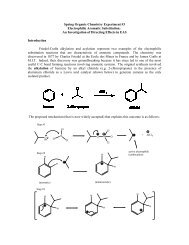Helen Keller
Helen Keller
Helen Keller
Create successful ePaper yourself
Turn your PDF publications into a flip-book with our unique Google optimized e-Paper software.
Name: Christine Hauck Date: October 7 th , 2002Content Area: ReadingUnit Topic: <strong>Helen</strong> <strong>Keller</strong>Today’s Lesson: <strong>Helen</strong> <strong>Keller</strong>-Chapter 3Grade Level: 11 th and 12 thDuration: 45 minutes(Special Education)LESSON RATIONALE:Standards:English / Language Arts:Standard 1:Students will read, write, listen, and speak for information and understanding.As listeners and readers, students will collect data, facts, and ideas; discoverrelationships, concepts, and generalizations; and use knowledge generated from oral,written, and electronically produced texts. As speakers and writers, they will use oral andwritten language to acquire, interpret, apply, and transmit.Standard 4:Students will read, write, listen, and speak for social interaction.Students will use oral and written language for effective social communication with awide variety of people. As readers and listeners, they will use the oral communications orothers to enrich their understanding of people and their views.Languages Other Than English:Standard 1:Communication SkillsStudents will be able to use a language other than English for communication.Standard 2:Cultural UnderstandingStudents will develop cross-cultural skills and understandings.Objectives:1. Students will comprehend 80% of chapter 3 in <strong>Helen</strong> <strong>Keller</strong> through class discussionand reflection questions. Comprehension2. Students will demonstrate their ability to fingerspell the alphabet with 50% accuracy.Application
3. Students will understand the definitions of the follow words; vibrations, growl,plunged, snatched, self-control through dictionary practice and context clues found inchapter 3 of <strong>Helen</strong> <strong>Keller</strong>. Comprehension4. Students will show their knowledge of different types of communication byparticipating in a group discussion and learning sign language. Knowledge5. Students will demonstrate their ability to read and write with 75% accuracy.Knowledge and ComprehensionAdaptations:• Students A and B will read with assisted help from another teacher.• Student B will have a scribe for the reflection questions.• Physical proximity is needed for student CMaterials:• Story <strong>Helen</strong> <strong>Keller</strong>• Alphabet in sign language• Chapter 3 vocabulary and comprehension worksheet• OverheadLESSON OPENING:“ Today we are going to continue to read of story of <strong>Helen</strong> <strong>Keller</strong>, but before we do letsreview what has happened in the previous chapters. We are going to play a game to helpus review the last chapter. The game is called brainracing. You are going to get intogroups of 3. When I say go you and your group will write as many things you canremember about the previous chapter. The group with the most facts will win.”“ Now based on the title (The Stranger Comes) of the chapter lets try and predict what isgoing to happen next.”LESSON BODY:1. Read Chapter 3 paying attention to vocabulary words and checking for understanding(C and D). (Checking for Understanding and Guided Practice)
2. Discuss some different ways of communication (D). (Guided Practice)3. Talk about what sign language is and different kinds of sign (D). (Guided Practice)4. Teach the students the alphabet in sign (C). (Guided Practice)5. Review how <strong>Helen</strong> learned to sign (C). (Guided Practice and Checking forUnderstanding)6. Model how to fingerspell into a partner’s hand. (Modeling of Activities) Have thestudents fingerspell the letters a, b, c into a partner’s hand and then have them try spellingtheir name into their partner’s hand (C). (Independent Practice and Checking forUnderstanding)7. Reflect on sign language through pair share – is it difficult to learn, do you think it washard for <strong>Helen</strong> to learn sign language (D). (Checking for Understanding)LESSON CLOSING:“Now that you have reflected upon these questions with your partner I would like you toshare with the whole group.” (Response) (Checking for Understanding)“I would like you to take the extra time and answer your comprehension questions. If youdon’t finish make sure you finish them for homework.” (Independent Practice andChecking for Understanding)Questions:1. Who is the stranger and why did she come?2. What was the stranger doing in <strong>Helen</strong>’s hand and why?3. Do you think <strong>Helen</strong> will ever learn self-control? Why or why not?LESSON FOLLOW-UP:What did you want the students to learn?1. Students will comprehend 80% of chapter 3 in <strong>Helen</strong> <strong>Keller</strong> through class discussionand reflection questions. Comprehension
2. Students will demonstrate their ability to fingerspell the alphabet with 50% accuracy.Application3. Students will understand the definitions of the follow words; vibrations, growl,plunged, snatched, self-control through dictionary practice and context clues found inchapter 3 of <strong>Helen</strong> <strong>Keller</strong>. Comprehension4. Students will show their knowledge of different types of communication byparticipating in a group discussion and learning sign language. Knowledge5. Students will demonstrate their ability to read and write with 75% accuracy.Knowledge and ComprehensionHow will you know they learned it?• Both the vocabulary and comprehension questions will be collected and graded.• Students will be observed when participating in reading, class discussions, andsigning.• Students will continue to show their knowledge of finger spelling throughout theunit.• The students will be expected to complete a final assessment at the end of the unit.LESSON RESOURCES:<strong>Helen</strong> <strong>Keller</strong>By: Margaret Davidson
















